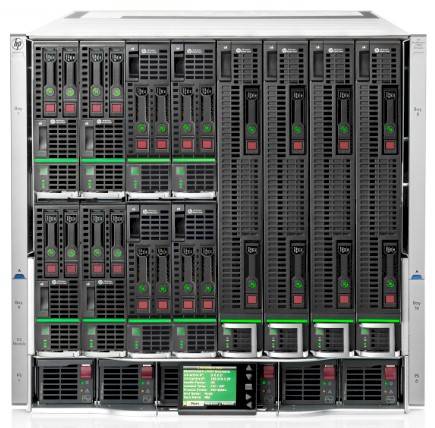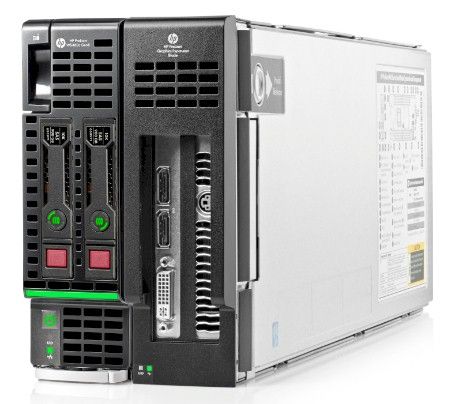Original URL: https://www.theregister.com/2013/02/19/hp_bladesystem_chassis_switch_workstation/
HP cranks up bandwidth on BladeSystem sheaths, adds pretty platinum stripe
Three-rank memory and 40GE downlinks for blades to match
Posted in Systems, 19th February 2013 16:44 GMT
When Hewlett-Packard launched the BladeSystem blade enclosures nearly seven years ago alongside its "blade everything" strategy, no one but Google was doing custom, high-density machines and it looked like blade servers would be the corporate platform of choice. And so HP built the c7000 chassis, and its smaller "Shorty" c3000 sibling that followed it to market, for the long haul. But the advent of faster server and storage networking is putting a strain on the backplanes in the existing BladeSystem enclosures, and so HP's engineers went back to the drawing board and rejiggered that passive backplane to offer more bandwidth, thus positioning the c3000 and c7000 Platinum editions for another couple of years at the very least.
The new c3000 and c7000 blade enclosures, which are debuting at the HP Global Partner Conference in Las Vegas this week, can accept all of the blade, switching, and storage devices that their predecessors were designed to envelope. The new enclosures are also getting a new integrated switch that is really design to be paired with the new chassis, and HP is rolling out fast SmartMemory options on another blade as well as a new WS460c Gen8 workstation server blade designed specifically for virtualized workstations used in conjunction with VMware View or Citrix Systems XenDesktop.
Same server skins, different backplane wires
From the outside, you would be hard-pressed to tell the new c-Class enclosures from their predecessors, and to help you out, HP has painted a platinum stripe on the enclosure ears at the front of the unit that screw the blade house into a server rack.
The c7000s, new or old, support eight full-height blades or sixteen half-height blades in a 10U rack enclosure. There are also storage, GPU coprocessor, and workstation blades for the chassis in addition to compute blades.
The backplane in the chassis is a passive component and is basically a bunch of wires, so boosting its bandwidth is not as trivial as designing a new ASIC and cranking the clock speed as you can do with a switch, explains John Gromala, director of product marketing for the Industry Standard Servers and Software division inside of HP's Enterprise Servers, Storage, and Networking group. Gromala says you have to have electrical engineers do very clever things with wires and signaling to allow the chassis to accept more and faster signally.
In this case, the new c7000 Platinum chassis has a backplane that has 7Tb/sec of aggregate bandwidth, which is up from the 5Tb/sec of bandwidth in the original c7000 chassis. That 40 per cent increase in bandwidth allows the new c-Class Platinum enclosures to drive lots of 56Gb/sec FDR InfiniBand and 10Gb/sec and now 40Gb/sec Ethernet adapters that snap onto ProLiant and Integrity blade servers. (The backplane hooks the adapters on the blades to the integrated switches in the enclosure, virtualizing those links through VirtualConnect if you use HP's own switches.)
The new backplane is also sufficiently fat to drive lots of 16Gb/sec Fibre Channel adapters, which reach out of the server nodes to Fibre Channel switches that link to storage area networks.
The beauty for HP BladeSystem customers is that any existing blade server that has shipped since 2006 can slide into this enclosure - and thus take advantage of that extra bandwidth in the backplane. If it has mezzanine adapter options, it can actually drive faster server and storage networks. (And if not, at least the slower links on older blades won't hit network traffic congestion if other blades in the new enclosure are running at higher bandwidths.)

The BladeSystem c7000 Platinum edition chassis populated with blades
The new c7000 Platinum chassis also has a number of other features, including its own location discovery and thermal discovery services, which complements the similar services that were embedded in the ProLiant Gen8 servers and their control freakery a year ago. So now you can have the chassis as well as the blades.
The ProLiant Gen8 rack servers announced last year had power supplies rated at the Platinum Plus rating (94 power efficiency at 230 volts), and the new c7000 Platinum enclosure does as well to match it. The c7000 chassis has room for six 2,450 watt power supplies that all of the gear in the chassis sucks on, and Paul Birney, director of blade and cloud product marketing for the Industry Standard Servers and Software division, tells El Reg that these power supplies will command a slightly higher price over the 92 percent efficient Gold Plus power supplies the c7000 has been using up to date. Presumably these more efficient power supplies also plug into the old enclosures. (There is no physical reason why they should not, but there may be a marketing reason.)
Both c7000 enclosures have eight interconnect blades in the back for networking, and the new c7000 Platinum has a shiny new one called the SX1018HP Ethernet switch, which is actually made by Mellanox Technologies for HP. This baby, which is based on the Mellanox SwitchX ASIC, has 16 downlinks running at 40GE speeds that feed through the backplane to mezzanine controllers on the server nodes and eighteen QSFP+ uplink ports.

The SX1018HP 40GE switch for the BladeSystem c7000 Platinum chassis
Not only does the SX1018HP switch have lots of bandwidth, but at 230 nanoseconds for a port-to-port hop running at 40GE, it has five times the effective bandwidth and one quarter the latency of prior 10GE switches. (If you run it at 10GE speeds, the latency is 250 nanoseconds.) The SX1018HP switch will ship for the new c7000 chassis in March, and you can put up to two inside the chassis for redundancy. Pricing information was not available for the SX1018HP. It can be used in conjunction with the ProLiant Gen8 BL420c, BL460c, BL465c, and BL660c blades.
The new c7000 Platinum enclosure will be available later in February and has a list price of $4,999. Presumably this is a higher list price than the current plain vanilla c7000 chassis. It is not clear when the c3000 Platinum chassis, which is a 6U enclosure than can be mounted in a rack or tipped on its side and rolled into offices, will ship. But there will be a c3000 Platinum edition and it will support up to eight half-height or four full-height blades, just like the vanilla c3000.
A blade for shared VDI workstations
HP is not launching new blade servers at its partner shindig this week in Vegas, but it is tossing out a new workstation blade that pairs a two-socket Xeon server blade with a sidecar that can hold up to eight Nvidia "Kepler" GPU coprocessors that are shared across those sockets. This would also make a killer base node for a supercomputer cluster if it turns out to be cheaper than the SL6500 scalable systems that HP is using to pair up large numbers of GPU coprocessors to dual-CPU nodes.
The important thing is that Kepler GPUs have features that allow for the GPU to be virtualized - much as the CPUs have been for ages. So when you are creating a virtual workstation to pipe down to a thin client or PC from the data center, you can allocate more CPU and GPU to customers who need better performance and cut back for those who do not at any particular time.
It allows for resources to be shared, and not just concurrently, but across different shifts. Moreover, you could also have customers use a basic VDI image for office work and then shift to a workstation VDI image only when they really need to run simulations or calculations that require all those GPUs.

The ProLiant WS460c workstation blade, with GPU sidecar
The feeds and speeds of the WS460c workstation blade were not available at press time, but word has clearly been making the rounds because Gromala says that "there are a lot more people interested in the WS460c than we can ship." That's a pretty good thing for a product that had not yet been announced.
El Reg can tell you that the workstation blade uses Nvidia's Mobile PCI Express Module (MXM) connector for laptops, which suggests that it does not support the super-high-end Kepler GPUs but rather Quadro and GeForce cards. We will let you know when we find out more.
The WS460c will be available in March with a starting list price of $5,037.
SmartMemory for the BL660c
Back in September 2012, HP launched the chubby four-socket BL660c blade server based on Intel's Xeon E5-4600 processors, and along with that it also launched a special three-rank, 24GB DDR3 memory stick that is priced the same as a 16GB memory stick but offers 25 per cent more memory performance because it clocks faster and consumes 35 per cent less power.
The memory controller in the Xeon E5 processors can support a certain number of channels and ranks per socket. With the SmartMemory, HP is sacrificing memory slots and cramming more memory ranks into a single DIMM, thus allowing it to boost the capacity of the DIMM by 50 per cent per stick. The upshot is that you can run the memory in a three-rank stick at the higher clock speed – in this case, at 1.3GHz – than you would be able to do with two-rank memory over a larger number of memory slots – in this case, you have to step down to 1.07GHz.
Anyway, with today's announcement, the two-socket BL460c that uses the Xeon E5-2600 processor now can use the three-rank SmartMemory modules across its eight memory slots, which boosts its memory capacity from 128GB using 16GB sticks to 192GB using the fat sticks designed by HP and built by a handful of memory makers. And remember, this memory runs faster and is priced the same as the 16GB sticks. ®